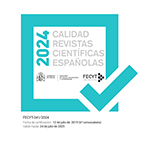Consideraciones sobre la lengua de las rimas políticas del Canzoniere de Petrarca
Abstract
Maurizio Vitale concludes his amazing, and relatively recent essay La lingua del «Canzoniere» di Francesco Petrarca (1996) stating that if Dante’s Commedia is the fundamental linchpin of written and spoken Italian language, the Canzoniere has been, throughout the history of linguistics, the model for literary Italian. In this work by Petrarch the use of language includes an evocative mixture of different stylistic features, even if diluted in a seeming uniformity. This is due to the strong literariness permeating all levels: from the phono morphological one to the syntactic or lexical one. In particular, it is the small sub-thematic group of works about the political dispute, to show the most realistic register of Petrarch’s language, in sharp contrast with the general strain of the Rerum vulgarium fragmenta. These works are: the Sonnet 27 and the Canzone 28, written on the occasion of the crusade of 1333; the Can - zone Spirito gentil and Italia mia, and three sonnets, 136 138, written against the papal court in Avignon.Downloads
##submission.format##
Licenza
La revista Cuadernos de Filología Italiana , para fomentar el intercambio global de conocimiento, permite el acceso sin restricciones a sus contenidos desde el momento de su publicación en la edición electrónica, por lo que es una revista de acceso abierto. Los originales publicados en esta revista son propiedad de la Universidad Complutense de Madrid y es obligatorio indicar su origen en cualquier reproducción total o parcial de la misma. Todos los contenidos se distribuyen con una licencia de uso y distribución.
Reconocimiento de Creative Commons 4.0 (CC BY 4.0).
Este hecho debe hacerse explícitamente en esta forma cuando sea necesario. Puede consultar la versión informativa y el texto de la licencia legal .
La revista Cuadernos de Filología Italiana no recibe honorarios por la presentación de trabajos o por la publicación de sus artículos.










